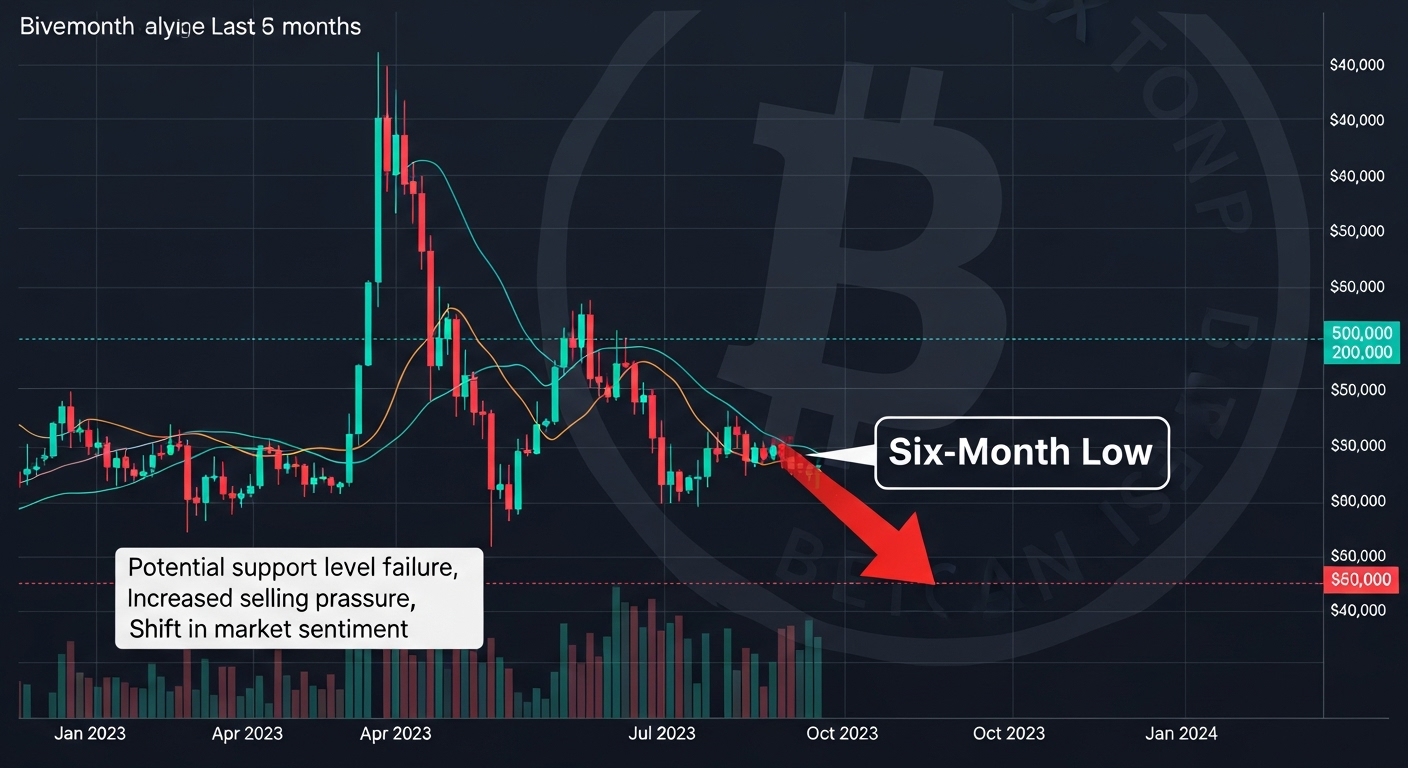Bitcoin dives to six month low amid US economic uncertainty again
Bitcoin dives to six-month low amid US economic uncertainty as rate fears and weak data rattle crypto. Learn what’s driving BTC now and what could come next.

Bitcoin has once again reminded investors why it is known for its volatility. After setting fresh highs earlier in the year, the world’s largest cryptocurrency has now dropped to a new six-month low, mirroring rising anxiety in the broader U.S. economy. Bitcoin dives to six month. As worries over interest rates, inflation, growth, and policy gridlock swirl, traders are pulling back from risk-on assets like Bitcoin and rotating into safer havens such as cash and government bonds.
This latest downturn has pushed the BTC price significantly below its recent peaks, wiping out a big chunk of year-to-date gains and introducing a harsher reality for latecomers who bought near the top. Recent data shows Bitcoin falling more than 20% from its all-time highs, with some sessions seeing sharp intraday declines as leveraged positions are liquidated across major exchanges.
At the same time, the macro backdrop has turned more complicated. Stronger-than-expected U.S. data has reduced expectations of rapid interest-rate cuts, while other indicators hint at a potential slowdown, creating a confusing mix for markets. When the economic picture is murky and monetary policy uncertain, volatility tends to spike in speculative corners of the market, especially in the cryptocurrency market.
In this in-depth breakdown, we’ll explore what pushed Bitcoin to this six-month low, how U.S. economic uncertainty is influencing crypto, what technical and on-chain signals are saying, and what the road ahead might look like for traders and long-term investors.
What triggered Bitcoin’s latest slide?
The immediate trigger for Bitcoin’s drop to a six-month low is a combination of macro shocks and market structure.
Over recent weeks, Bitcoin has steadily drifted lower from its highs as traders reassessed expectations for Federal Reserve rate cuts and digested a string of U.S. economic releases. Strong labor and services data earlier in the year led investors to believe rates might stay elevated for longer, pushing up Treasury yields and weighing on high-risk assets such as Bitcoin and tech stocks.
As risk sentiment deteriorated, sell orders intensified. On several days, Bitcoin fell through key support levels that had held for months. Once those levels broke, automated trading systems and stop-loss orders amplified the move, accelerating the decline toward the six-month low. In some sessions, hundreds of millions of dollars’ worth of leveraged long positions were liquidated, compounding the downward pressure.
Another factor is weakening liquidity. Market depth data shows that the amount of limit orders near the market price has thinned out, meaning relatively modest sell orders can push the BTC price more aggressively than before. When liquidity is shallow, news shocks and sentiment swings cause outsized moves, which is exactly what we’re seeing as Bitcoin dives to a multi-month trough.
In short, the six-month low is not the result of a single headline. Instead, it is the outcome of a fragile market structure colliding with a period of macro uncertainty, tighter financial conditions, and skittish investor psychology.
How US economic uncertainty is shaking crypto

Mixed economic data and shifting Fed expectations
Bitcoin’s latest slump is closely tied to conflicting signals coming from the U.S. economy. On one hand, strong jobs numbers and resilient services data suggest that growth remains reasonably intact. On the other hand, weaker manufacturing surveys, soft consumer sentiment readings, and worries about future demand have raised fears of a potential economic slowdown or even a mild recession.
These mixed signals make it very difficult for markets to predict what the Federal Reserve will do next. At times, traders price in aggressive rate cuts, expecting the Fed to support growth. Then, stronger data or sticky inflation prints cause those expectations to be dialed back. Each swing in the outlook for interest rate cuts or hikes impacts risk assets, especially Bitcoin, which has become highly sensitive to macro narratives.
When recession fears rise and the odds of policy missteps climb, investors often adopt a risk-off stance. Capital flows out of crypto assets, speculative tech names, and high-beta stocks, and into short-term Treasuries, the U.S. dollar, and other perceived safe-haven assets. Bitcoin, once marketed as digital gold, does not always behave defensively during these episodes; instead, it frequently trades like a high-octane risk asset that gets sold when uncertainty is highest.
Strong dollar, higher yields, and pressure on BTC
One of the clearest channels through which U.S. uncertainty affects Bitcoin is the U.S. dollar and bond markets. When investors worry about the economic outlook, they often buy dollars and Treasuries, especially if they believe U.S. interest rates will remain higher than those of other advanced economies. Rising real yields make non-yielding assets like Bitcoin less attractive on a relative basis.
A stronger dollar also weighs on global liquidity. Many institutional crypto investors operate cross-asset portfolios where currency moves matter. When the dollar rallies, it tightens financial conditions worldwide, leaving less capacity and appetite for leveraged bets in crypto markets. The result is that Bitcoin’s price often struggles during periods of dollar strength and elevated bond yields, especially when accompanied by headlines about potential recession or persistent inflation.
Investor sentiment: from euphoria to caution
Retail FOMO giving way to fear
Earlier in the year, as Bitcoin approached and briefly exceeded prior highs, retail investors flooded back into the market. Social media buzz, influencer content, and rising spot Bitcoin ETF volumes fed a classic FOMO cycle, with many new buyers entering after an already strong rally.
Now that Bitcoin has retreated to a six-month low, those same investors are facing unrealized losses or much thinner profits. For traders who bought near the top and used leverage, the decline has been especially painful. As liquidations stack up and volatility spikes, retail sentiment can switch from optimism to fear remarkably fast. Search trends and social data already show rising interest in terms like “why is Bitcoin going down” and “Bitcoin crash”, reflecting growing anxiety.
This shift in mood is important because retail participation often acts as a momentum amplifier. When small traders become cautious and stop “buying the dip,” it becomes harder for Bitcoin to quickly bounce back from support zones.
Long-term holders and institutional flows
A notable feature of the current decline is that even long-term holders—wallets that historically seldom sell—have been taking profits or reducing exposure. On-chain data shows an uptick in coins moved out of dormant addresses onto exchanges, a pattern typically associated with distribution rather than accumulation.
At the institutional level, flows into spot Bitcoin products and derivatives have turned more mixed. Some weeks have recorded net outflows from Bitcoin ETFs and institutional funds, signaling that big players are trimming risk. Other weeks show modest inflows, suggesting that a subset of institutions still views these dips as strategic entry points. Overall, however, the conviction that characterized earlier stages of the bull run has cooled
The combination of cautious retail traders, profit-taking long-term holders, and inconsistent institutional flows is a recipe for choppy, range-bound price action, where rallies fade quickly and support levels are frequently retested.
Technical picture: why the six-month low matters

From a technical analysis standpoint, Bitcoin’s dive to a six-month low is significant because it resets many of the bullish structures that were in place earlier in the year.
Over the last half-year, Bitcoin traded within a broad range, establishing key support and resistance levels. The recent breakdown pushed the price below the lower boundary of this range, turning what was once support into new resistance. Chart watchers now point to these zones as areas where sellers may re-emerge if Bitcoin attempts a rebound.
Many analysts also track moving averages like the 50-day and 200-day moving averages. When the BTC price slips below these trend markers, it can trigger systematic selling and reduce confidence in the short-term uptrend. A sustained move below the 200-day average is often viewed as a sign that the market has shifted from a bullish phase to a more neutral or even bearish phase, at least temporarily.
Psychological price levels add another layer of pressure. Just as earlier breaks above round numbers like $100,000 fueled enthusiasm, drops below key thresholds can unsettle traders. Crossing below such levels tends to increase volatility as both bulls and bears aggressively defend their positions. The fact that this downside break coincides with broader macroeconomic headwinds makes it more impactful than a purely technical event.
Impact on the wider cryptocurrency market
Bitcoin’s status as the flagship cryptocurrency means its movements ripple across the entire digital asset ecosystem. When Bitcoin dives to a six-month low, it is rare for altcoins to remain unscathed.
Historically, sharp BTC drawdowns trigger even larger percentage declines in altcoins, especially smaller-cap tokens and highly speculative projects. Many of these coins have already underperformed during the recent correction, reflecting a flight to relative safety within crypto itself, as some investors rotate from volatile altcoins back into Bitcoin or stablecoins.
DeFi protocols, NFT markets, and Web3 infrastructure tokens also tend to feel the impact. Lower token prices reduce the dollar value of collateral in lending protocols, raising liquidation risks for over-leveraged users. Trading volumes on decentralized exchanges may decline as speculative activity cools. Projects relying on token sales or treasuries for funding can find their runway shortened when prices fall sharply.
On the other hand, periods of market stress can flush out weaker projects and unsustainable yield schemes, allowing stronger networks and teams to consolidate their position. For long-term builders and investors, a Bitcoin-led reset can create a healthier foundation for future growth, even if the short-term pain is severe.
Lessons for investors during heightened volatility
For individual investors trying to navigate this environment, Bitcoin’s drop to a six-month low offers several important lessons.
First, volatility is not a bug; it is a feature of Bitcoin and the broader crypto market. Prices can move dramatically in both directions in response to macro headlines, regulatory developments, or purely technical triggers. Investors should size positions with the expectation of large swings, rather than being surprised when they happen.
Second, risk management is crucial. Relying heavily on leverage or allocating an outsized portion of a portfolio to Bitcoin can turn a normal correction into a portfolio-level crisis. Many of the forced liquidations seen during the recent sell-off came from traders who were over-leveraged and unable to withstand even a short-term move against their positions.
Third, time horizon matters. Long-term investors who view Bitcoin as a form of digital store of value or a hedge against currency debasement often approach these declines differently from short-term traders. Instead of panic-selling, they may continue to dollar-cost average or simply hold through the cycle, believing that macro trends like digitization of finance and limited BTC supply will play out over many years.
None of this guarantees future returns, and Bitcoin remains a high-risk asset. But understanding the interplay between macro uncertainty, market structure, and investor psychology can help participants avoid emotional decisions at precisely the worst times.
See More: Bitcoin Mining Stock Canaan Sinks 16% What Happened
Possible scenarios for Bitcoin’s next move
With Bitcoin at a six-month low amid U.S. economic uncertainty, several paths are possible from here. While no one can predict the exact trajectory, we can outline a few broad scenarios that traders and investors are considering.
Extended consolidation and choppy range
In this scenario, Bitcoin has already absorbed the bulk of the bad macro news and position unwinds, but lacks a strong catalyst for a new bull leg. Price action could remain choppy, oscillating between the recent lows and newly established resistance levels.
Such a range-bound phase would allow the derivatives market to normalize, funding rates to reset, and long-term holders to re-evaluate allocations. Volatility might remain elevated but gradually decline as speculative excess is flushed out. Historically, Bitcoin has often spent months consolidating after major moves before choosing a new direction.
Deeper pullback amid worsening macro conditions
If U.S. economic data deteriorates further—showing a sharper slowdown or stagflation—while policymakers remain constrained, risk assets could face additional pressure. A deeper recession scare, another bout of stress in the banking or corporate credit sectors, or a resurgence of inflation could all trigger renewed risk-off waves.
In that case, Bitcoin could break below its current six-month low, testing lower support zones flagged by technical analysts and on-chain metrics. Such a move would likely be accompanied by further outflows from crypto funds, more leverage washouts, and another hit to retail and institutional confidence.
Macro relief and renewed upside
A more optimistic path would see U.S. inflation gradually easing while growth remains positive, allowing the Federal Reserve to signal a more predictable, gradual path toward lower rates. Clearer policy guidance and reduced fear of a hard landing could improve sentiment across both traditional and digital markets.
Under this scenario, investors might rotate back into risk-on assets, including Bitcoin. Fresh inflows into spot Bitcoin products, renewed institutional interest, and improving liquidity could help BTC reclaim key moving averages and reverse some of the recent drawdown. Historically, Bitcoin has often staged strong recoveries once macro clouds lift and market positioning turns less crowded.
The reality may blend elements of all three scenarios over time. What matters most for investors is having a strategy that can withstand multiple outcomes rather than relying on a single prediction.
Final thoughts
Bitcoin’s slide to a six-month low is a powerful reminder that crypto does not trade in isolation. As the U.S. economy navigates a complex mix of inflation concerns, growth risks, changing monetary policy, and political uncertainty, Bitcoin’s price will continue to react to shifts in the broader narrative.
For some, this volatility is a sign to stay away. For others, it is precisely what makes Bitcoin interesting: an asset at the crossroads of technology, finance, and macroeconomics, whose value is shaped by both code and human psychology.
Whether you see this six-month low as a warning sign or an opportunity, the key is to understand the forces at work. US economic uncertainty, shifting expectations around interest rates, changing investor sentiment, and evolving regulation all play crucial roles in shaping Bitcoin’s trajectory.
As always, anyone considering exposure to Bitcoin or other cryptocurrencies should do thorough research, assess their own risk tolerance, and avoid investing money they cannot afford to lose. The crypto market rewards patience, discipline, and education far more than impulsive trades made in moments of fear or euphoria.



